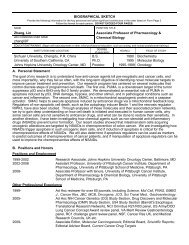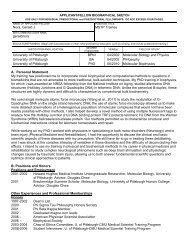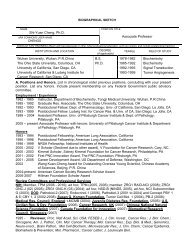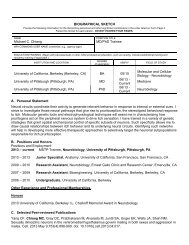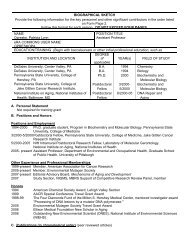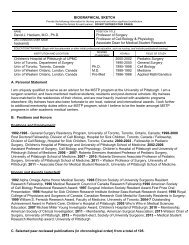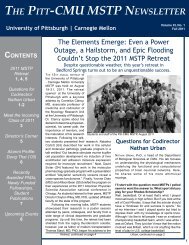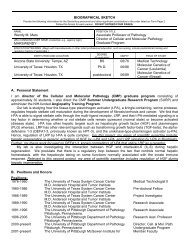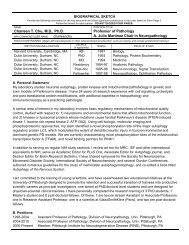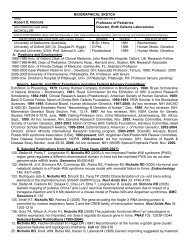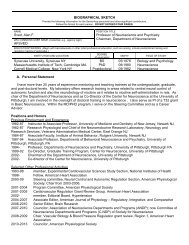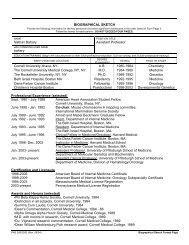Inside... - University of Pittsburgh :: MSTP
Inside... - University of Pittsburgh :: MSTP
Inside... - University of Pittsburgh :: MSTP
You also want an ePaper? Increase the reach of your titles
YUMPU automatically turns print PDFs into web optimized ePapers that Google loves.
The Pitt-CMU <strong>MSTP</strong> Newsletter<br />
Volume VIII, No. 1<br />
Fall 2009<br />
Celebrating Old Traditions, Creating New Traditions<br />
Yearly innovations at 13th Annual <strong>MSTP</strong> Retreat bring new life to even student-favorite events<br />
The 13th annual Pitt/CMU <strong>MSTP</strong><br />
retreat was held at the <strong>University</strong> <strong>of</strong><br />
<strong>Pittsburgh</strong> Biomedical Science Tower<br />
and Seven Springs Resort. Dr. David<br />
Hackam opened the retreat with his<br />
keynote address entitled “Adventures <strong>of</strong> a<br />
Surgeon Scientist: Turning a Dark Knight<br />
into a Quantum <strong>of</strong> Solace,” his compelling<br />
story <strong>of</strong> being an academic surgeon<br />
with a thriving research program aimed to<br />
understand and therapeutically target the<br />
pathogenesis <strong>of</strong> necrotizing enterocolitis<br />
(NEC) in premature infants.<br />
Next, students listened to research<br />
presentations given by Christin Glorioso<br />
(G5) and Cyrus Raji (MS3) as well as a<br />
Above top left: Dr. Guillermo Romero accepts the 2009 William E.<br />
Brown Outstanding <strong>MSTP</strong> Mentor Award. Above top right: Students<br />
speak with peers and faculty about their research at the Friday morning<br />
poster session. Above: The Pitt-CMU <strong>MSTP</strong>, Retreat 2009. (Photo<br />
credits: Benjamin Mantell (G2) and <strong>University</strong> <strong>of</strong> <strong>Pittsburgh</strong> CIDDE)<br />
report from the students who attended<br />
the National MD/PhD Student Conference<br />
this year. Meanwhile, participating<br />
faculty met with <strong>MSTP</strong> Director Dr.<br />
Clayton Wiley for the latest news and<br />
updates about our program. Students<br />
and faculty convened once more for the<br />
poster sessions. This year, students<br />
were grouped by graduate program<br />
rather than alphabetically, allowing for<br />
more efficient interaction among student<br />
and faculty researchers within the<br />
same field.<br />
Awards were presented during<br />
lunch. The recipient <strong>of</strong> the 2009 William<br />
E. Brown Outstanding Mentor Award<br />
was Guillermo Romeo,<br />
PhD (pharmacology and<br />
chemical biology), and<br />
the recipient <strong>of</strong> the Drs.<br />
S. Sutton Hamilton <strong>MSTP</strong><br />
Scholar Award was Sherrie<br />
Divito, PhD (MS3).<br />
Many congratulations<br />
to both well-deserving<br />
awardees!<br />
A group photo-graph<br />
in rare <strong>Pittsburgh</strong> sunny<br />
weather concluded the Friday<br />
Research Day events,<br />
and we packed up our<br />
posters before heading<br />
out to Seven Springs.<br />
An Italian buffet awaited<br />
us at Seven Springs,<br />
as well as an inaugural<br />
Quizzo showdown bet<br />
w e e n p r e - a r r a n g e d<br />
groups composed <strong>of</strong> students<br />
from every level <strong>of</strong><br />
the program. Mark Doyal<br />
(G2), Jeffrey Koenitzer<br />
(G2) and David Wheeler (G2) wrote and<br />
hosted the Quizzo event, perplexing<br />
students, program administration, and<br />
guests with questions encompassing<br />
history, <strong>Pittsburgh</strong> trivia, Step 1 USMLE<br />
material, geography, pop culture, and<br />
<strong>MSTP</strong>-related trivia such as “How tall<br />
is Dr. Wiley” The winning team was<br />
promised a selection <strong>of</strong> cookies baked<br />
by retreat co-chair Liang Kang (G2).<br />
Students spent the rest <strong>of</strong> the night<br />
singing Karaoke and partaking in other<br />
activities. At 10:30 p.m., the first-year<br />
class was escorted for the revival <strong>of</strong> the<br />
annual “welcoming <strong>of</strong> the first years”:<br />
a trek, on foot, straight up the steep<br />
and slippery Seven Springs ski slope,<br />
a challenging climb aptly described as<br />
symbolic <strong>of</strong> their <strong>MSTP</strong> training to come.<br />
Dr. Clayton Wiley started Saturday<br />
morning events with his annual “State <strong>of</strong><br />
the Program” presentation and discussion.<br />
This was followed by a completely<br />
new component to the <strong>MSTP</strong> retreat: a<br />
formal career advice presentation by an<br />
alumnus, given this year by David Volk,<br />
MD, PhD (Class <strong>of</strong> 2004), Assistant<br />
Pr<strong>of</strong>essor <strong>of</strong> Psychiatry at the <strong>University</strong><br />
<strong>of</strong> <strong>Pittsburgh</strong>. Students responded<br />
enthusiastically to the added detail and<br />
time for discussion <strong>of</strong> Dr. Volk’s experiences<br />
and advice.<br />
Peer mentoring tables were arranged<br />
for lunch, after which the rising<br />
MS4s gave pithy and humor-filled<br />
presentations about their experiences<br />
in the program and advice for younger<br />
students. Students then split up for<br />
pr<strong>of</strong>essional development workshops.<br />
Students attended one <strong>of</strong> three <strong>of</strong>fered:<br />
see page 3, Retreat<br />
<strong>Inside</strong>...<br />
2009 <strong>MSTP</strong> Retreat, 1, 3<br />
Alumni Updates:<br />
Michael Pezzone, 2, 6<br />
Co-Director’s Corner, 3<br />
Non-Traditional Residency<br />
Advice, 4-5<br />
Introducing the First Years, 5<br />
Recently Awarded PhDs, 6<br />
Newly Funded F30s, 6<br />
Student Publications, 7<br />
Upcoming Events, 8
Pr<strong>of</strong>iles in Medicine: Michael Pezzone<br />
An alumnus from the Class <strong>of</strong> 1994 shares his rewarding experiences as an <strong>MSTP</strong> student and<br />
now a physician-scientist at Pitt<br />
2<br />
The marking <strong>of</strong> the 25th anniversary<br />
<strong>of</strong> our <strong>MSTP</strong> in 2008 allowed many<br />
alumni <strong>of</strong> our program a walk down<br />
memory lane. “I remember there weren’t<br />
too many students ahead <strong>of</strong> me in the<br />
program here in <strong>Pittsburgh</strong>,” reminisces<br />
Dr. Michael Pezzone, now an Associate<br />
Pr<strong>of</strong>essor <strong>of</strong> Pharmacology & Chemical<br />
Biology and Medicine in the Division<br />
<strong>of</strong> Gastroenterology, Hepatology and<br />
Nutrition. Dr. Pezzone graduated from<br />
the program in 1994 and recalls only<br />
three people being in his <strong>MSTP</strong> class.<br />
He notes how far the program has<br />
come from when he started in 1987,<br />
“I think after so many years <strong>of</strong> this<br />
program’s existence, you really start<br />
to get a consensus for what is best for<br />
the students.” He specifically noted<br />
how the career development courses<br />
in grant writing and ethics, which were<br />
not in existence while Dr. Pezzone was<br />
a student, have really helped contribute<br />
to the breadth <strong>of</strong> knowledge that is<br />
imparted to students by the <strong>Pittsburgh</strong><br />
<strong>MSTP</strong>.<br />
After graduating as valedictorian<br />
<strong>of</strong> his high school class in New Castle,<br />
Pa., Dr. Pezzone studied at Cornell<br />
<strong>University</strong>, majoring in chemistry and<br />
biology. Dr. Pezzone was drawn to<br />
chemistry mainly because “it isn’t just<br />
a didactic type <strong>of</strong> science, I really enjoy<br />
the hands-on aspects <strong>of</strong> it, including lab<br />
work.” At the time, his undergraduate<br />
program was designed with a year <strong>of</strong><br />
research which allowed him to work on<br />
his honors thesis <strong>of</strong> “Structure-activity<br />
relationships in glycosidase inhibitors.”<br />
His research with Dr. Bruce Ganem in<br />
the Department <strong>of</strong> Chemistry resulted in<br />
a publication as an undergraduate, and<br />
he graduated cum laude in 1987.<br />
The summer prior to medical school<br />
matriculation, Dr. Pezzone did research<br />
at the <strong>University</strong> <strong>of</strong> <strong>Pittsburgh</strong> through<br />
the Mellon Pre-doctoral Fellowship in<br />
Psychiatry, during which time he studied<br />
an autoimmune basis for schizophrenia.<br />
From this research experience he soon<br />
realized “immunology, stress, and<br />
autoimmunity seemed to be areas <strong>of</strong><br />
research (he) enjoyed working on.”<br />
Although Dr. Pezzone did not<br />
formally apply to a dual-degree program,<br />
he had heard <strong>of</strong> combined degree MD-<br />
PhD programs as an undergraduate.<br />
During the late eighties however, there<br />
were not many MD-PhD programs<br />
that were well structured. Dr. Pezzone<br />
elected to hold <strong>of</strong>f joining a MD-PhD<br />
program until he had started medical<br />
school, as the first two years would<br />
be identical whether or not he was in a<br />
combined degree program.<br />
It was fortuitous that Dr. Pezzone<br />
was working in the lab <strong>of</strong> Dr. Bruce Rabin<br />
when he started medical school, who<br />
was then the director <strong>of</strong> the MD-PhD<br />
program. Dr. Rabin mentored the predoctoral<br />
Pezzone and encouraged him<br />
to apply to the program. On comparing<br />
the opportunities he had for research at<br />
that time, Dr. Pezzone recalls that “back<br />
then there weren’t too many options<br />
available. For example, I had initially<br />
wanted to do research in cardiology,<br />
but there weren’t too many benchtop<br />
cardiology options available like there<br />
are now. It kind <strong>of</strong> limited what you could<br />
go into.”<br />
Dr. Pezzone joined the graduate<br />
department <strong>of</strong> Experimental Pathology,<br />
continuing to work with Dr. Rabin<br />
on a project titled “Characterization<br />
<strong>of</strong> the Pathways Mediating Stress-<br />
Induced Immune Alterations in the<br />
Rat.” His primary interests were in<br />
identifying central neural pathways and<br />
neurondrocine pathways and how these<br />
modulate immune function. “The nice<br />
thing about pathology is you can do<br />
anything with what you learn in graduate<br />
work. It is a field that encompasses and<br />
is easily applicable to many areas.”<br />
Later, after graduate school, when<br />
he was trying to find a specialty to pick<br />
based on his background and research<br />
interests, “everything seemed to lead to<br />
working with gastrointestinal disease<br />
and irritable bowel syndrome. Internal<br />
medicine in general seemed to have<br />
the most flexibility to it, and having the<br />
ability to see patients was a plus for<br />
me.”<br />
Upon graduation, Dr. Pezzone<br />
continued his training at UPMC, joining<br />
the Internal Medicine Residency<br />
Program in 1994. He was one <strong>of</strong> the<br />
first to take the Clinical Investigator<br />
Pathway, which combines research<br />
and clinic time for the first two years<br />
<strong>of</strong> the program. Dr. Pezzone started<br />
working with Dr. William de Groat in the<br />
Department <strong>of</strong> Pharmacology, who was<br />
studying pelvic visceral pain, and he<br />
found many overlapping mechanisms<br />
and pathways when comparing Dr. de<br />
Groat’s work with the visceral bowel<br />
pain that he was interested in studying.<br />
During his gastroenterology fellowship<br />
at UPMC, Dr. Pezzone continued<br />
studying neuro-immune interactions<br />
and pain and was able to start his<br />
fellowship doing independent research<br />
because <strong>of</strong> the industry funding he<br />
already had obtained on his own. Less<br />
than two years into his fellowship, Dr.<br />
Pezzone was granted a K award on<br />
neuroimmune mechanisms <strong>of</strong> visceral<br />
hyperalgesia, and subsequently he was<br />
promoted to a faculty position.<br />
Despite the current funding<br />
environment being less than favorable,<br />
Dr. Pezzone is currently working on<br />
approximately 5 clinical trials, and<br />
spending 40 perccent <strong>of</strong> his time<br />
working on research and 60 percent <strong>of</strong><br />
his time in the clinic. He teaches lectures<br />
see page 6, Pezzone
Tumor growth is highly dependent on its<br />
microenvironment. Surrounding stroma,<br />
including fibroblasts, my<strong>of</strong>ibroblasts,<br />
leukocytes, and endothelial cells can<br />
affect the invasive behavior, growth,<br />
polarity, and differentiation <strong>of</strong> cancer<br />
cells. Induced death <strong>of</strong> stromal cells<br />
has led to death <strong>of</strong> co-cultured prostate<br />
cancer cells in vitro and to tumor<br />
shrinkage in vivo. Stromal cells are<br />
themselves altered by proximity to<br />
cancer cells and this “reactive stroma”<br />
acquires tumor-promoting activity in vivo.<br />
Cancer cells and normal cells in their<br />
microenvironment are interdependent<br />
and evolve together by conducting a<br />
dynamic molecular dialogue.<br />
Students in the <strong>MSTP</strong> are not<br />
malignant. I have in fact been impressed<br />
by the smooth scientific differentiation,<br />
cooperativity, and organic pr<strong>of</strong>essional<br />
growth <strong>of</strong> members <strong>of</strong> our student body.<br />
But we do take a page from cancer<br />
physiology. A goal <strong>of</strong> training for <strong>MSTP</strong><br />
students is to develop skills that do not<br />
die, knowledge that proliferates, and<br />
an ability to adapt and thrive both in<br />
familiar and in challenging scientific and<br />
intellectual environments.<br />
One <strong>of</strong> the primary mechanisms<br />
that supports the survival and growth<br />
<strong>of</strong> the <strong>MSTP</strong> student is the process <strong>of</strong><br />
social learning. Even a casual observer<br />
<strong>of</strong> our <strong>MSTP</strong> would recognize that social<br />
learning is constitutively active within and<br />
outside <strong>of</strong> the classroom. The Research<br />
Basis <strong>of</strong> Medical Knowledge class<br />
<strong>of</strong>fers a venue for vertical transmission<br />
<strong>of</strong> knowledge, presentation styles, and<br />
charisma from MS2 to MS1 students<br />
(and challenging questions in the<br />
other direction) ins<strong>of</strong>ar as first- and<br />
second-year students join together for<br />
a portion <strong>of</strong> the class.<br />
It has been a pleasure<br />
to see students in our<br />
interactive enrichment<br />
classes manifest depth<br />
<strong>of</strong> thinking rather than<br />
death <strong>of</strong> thinking. The chemistry within<br />
and between years is also evident in<br />
the effectiveness and creativity <strong>of</strong> the<br />
many student committees that support<br />
and shape <strong>Pittsburgh</strong>’s <strong>MSTP</strong>. Input<br />
from most <strong>of</strong> you and from faculty<br />
indicates that the graduate years and the<br />
longitudinal clinical clerkship succeed in<br />
providing role models, bilateral learning,<br />
and pr<strong>of</strong>essional growth.<br />
I have been impressed by<br />
discussions with students in which they<br />
indicate an interest in choosing thesis<br />
committee faculty whose participation<br />
will benefit them both in terms <strong>of</strong> scientific<br />
input and longitudinal networking. Such<br />
an active approach i.e., “what do I want<br />
to get out <strong>of</strong> my committee/attendees<br />
at my talks/interviewers for positions,<br />
etc.,” rather than “what will they want<br />
from me” can help you to control your<br />
Co-Director’s Corner<br />
A Message From Richard Steinman, MD, Ph D<br />
Co-Director <strong>of</strong> <strong>MSTP</strong><br />
own trajectory as a physician, scientist.<br />
Currently, a student-facultyadministration<br />
committee is re-evaluating<br />
and revising the <strong>MSTP</strong> curriculum to<br />
optimize its objectives and coherence<br />
and to minimize redundancy. Within this<br />
curriculum, we anticipate (more later)<br />
three successive summer pr<strong>of</strong>essional<br />
development courses starting prior to<br />
MS1. These will be framed to build<br />
skills and a knowledge base relevant<br />
to each stage <strong>of</strong> students’ progression<br />
through the <strong>MSTP</strong>. In combination with<br />
the expertise derived from MD and PhD<br />
training and other enrichment classes,<br />
we hope that this equips our students<br />
to triumph over obstacles in their<br />
future training, disseminate widely and<br />
seed new biomedical paradigms that<br />
bolster health.<br />
Retreat, from page 1<br />
Choosing a research mentor (with Dr.<br />
Guillermo Romero), Negotiating your<br />
first job (with Dr. Clayton Wiley), and<br />
Scientific writing and revising (with Michelle<br />
Kienholz).<br />
A few hours <strong>of</strong> sun, volleyball,<br />
swimming, tennis, or sleep was enjoyed<br />
before the banquet dinner and keynote.<br />
Dr. Paul Rosen presented the evening<br />
keynote address, challenging students<br />
to seek to gain skills that would<br />
help them not only as researchers<br />
and clinicians but also to be able to<br />
recognize and optimize human factors<br />
variables that affect patient care.<br />
With the conclusion <strong>of</strong> the<br />
<strong>of</strong>ficial retreat program, students<br />
enjoyed the rest <strong>of</strong> the evening with a<br />
poker tournament, jam session, or other<br />
activities. Sunday activities included<br />
paintball, golf, and whitewater rafting.<br />
by Liang Kang (G2)<br />
Above top: <strong>MSTP</strong> students intently playing<br />
poker. Above: Dr. Stetten, Maxx Horowitz<br />
(G3), and Danny Roh (G3) jam together on<br />
their guitars. Right top: The MS2s rock it<br />
out in Karaoke with a rousing rendition <strong>of</strong><br />
“Wake me up before you go go” by Wham!<br />
Right: MS1s and some upperclassmen take<br />
the symbolic hike up the Seven Springs ski<br />
slope. (Photo credits: Liang Kang (G2))<br />
3
How to navigate non-traditional residencies<br />
One alumnus’s experiences and perspective on the post-graduate training opportunities outside<br />
medical residencies and how to maximize your degrees to find the one that fits you.<br />
4<br />
<strong>MSTP</strong> graduates have a venerable<br />
collection <strong>of</strong> skills: a comprehensive fund<br />
<strong>of</strong> knowledge, the ability to communicate<br />
complex information to a broad range <strong>of</strong><br />
audiences, the ability to synthesize data<br />
in literature, and the capacity to become<br />
world experts in medical science. The<br />
job <strong>of</strong> a physician-scientist is a natural<br />
extension <strong>of</strong> these skills. However,<br />
it is important to realize that being a<br />
physician-scientist is not the only career<br />
option available to <strong>MSTP</strong> graduates.<br />
My Path<br />
My story serves as an example <strong>of</strong> a<br />
non-traditional approach to post-<strong>MSTP</strong><br />
training. I plan to use engineering<br />
innovation to improve health care<br />
efficiency and affordability through<br />
entrepreneurship. This broad goal<br />
includes fields such as medical<br />
technology, medical informatics, and<br />
medical robotics. In seven years or<br />
so, I would like to be responsible for<br />
bringing together university research,<br />
industry, and investors to create private<br />
companies to address these issues.<br />
Coming to the decision not<br />
to pursue a medical residency was<br />
extremely challenging, requiring months<br />
<strong>of</strong> self-reflection about my career goals,<br />
skill set, and risk tolerance. As I spoke<br />
with friends and colleagues about<br />
the choice and my goals became<br />
more specific, I began to identify local<br />
organizations to help me determine what<br />
the next step should be. Ultimately, I<br />
settled on a list <strong>of</strong> three potential career<br />
paths: management consulting, midsized<br />
company, and entrepreneurial<br />
fellowship.<br />
Advice<br />
I believe there are common elements<br />
to career planning that can benefit all<br />
students. The most important point is<br />
that the immediate years after the <strong>MSTP</strong><br />
should be viewed as a “residency.” It is<br />
difficult to immediately step into a high<br />
level pr<strong>of</strong>essional job after the <strong>MSTP</strong>. We<br />
are simply not ready. Early post-<strong>MSTP</strong><br />
life is typically an intense 3-5 year period<br />
<strong>of</strong> relatively little income, long hours,<br />
and a precarious sensation <strong>of</strong> drowning.<br />
In exchange, the Residency teaches<br />
critical skills, supplies performance<br />
feedback, and helps build a network <strong>of</strong><br />
contacts that will establish and maintain<br />
a career.<br />
I have found that there are 3 key<br />
considerations when selecting a good<br />
Residency:<br />
1) Obtain Missing Skills. First, one<br />
must concretely define a job description.<br />
Instead <strong>of</strong> selecting a job title the goal is to<br />
identify critical career accomplishments,<br />
which may or may not align with job<br />
title. Second, one must identify the key<br />
ingredients required to accomplish the<br />
critical career goals. This step cannot<br />
be performed in a vacuum; it requires<br />
online research and face-to-face<br />
communication with people <strong>of</strong> different<br />
backgrounds who have already achieved<br />
these goals. Finally, one must perform a<br />
“...maximally leveraging your<br />
training means understanding<br />
what your future employer<br />
will value...and then recasting<br />
<strong>MSTP</strong> training to match<br />
those values.”<br />
self evaluation to determine both missing<br />
skills and existing strengths. This step<br />
requires brutal honesty or the consult<br />
<strong>of</strong> several honest mentors. Successfully<br />
performing this step helps both to select<br />
the best residency and to maximize the<br />
chance <strong>of</strong> getting into that residency.<br />
2) Get Mentorship. The value <strong>of</strong><br />
mentorship cannot be overstated.<br />
Multiple mentors in different fields and<br />
career stages have incalculable career<br />
benefit. Mentors can provide an unbiased<br />
ear for ideas, feedback, personal<br />
connections, and recommendation<br />
letters. Many individuals have helped me<br />
secure interviews, connect with program<br />
directors, and on occasion get hired<br />
without applying.<br />
3) Maximally Leverage Your Training.<br />
Dr. Jenny Grandis is an <strong>MSTP</strong> mentor<br />
whose life is an outstanding example<br />
<strong>of</strong> how to combine clinic, research, and<br />
family. She emphasizes that an MD/<br />
PhD is qualitatively different from either<br />
an MD or PhD, and <strong>MSTP</strong> graduates<br />
should carve out a niche unto their own,<br />
in effect “branding” themselves. This<br />
is relatively easy in medical residency,<br />
since most residency directors know the<br />
value <strong>of</strong> <strong>MSTP</strong> applicants in increasing<br />
department funding and prestige. In<br />
exchange, physician-scientists can<br />
negotiate to expedite their training.<br />
Thus, <strong>MSTP</strong> training can be maximally<br />
leveraged in research-intensive medical<br />
residencies. In other Residencies, the<br />
value <strong>of</strong> MD/PhD training is variable.<br />
However, regardless <strong>of</strong> Residency<br />
type, maximally leveraging your training<br />
means understanding what your future<br />
employer will value in the near term and<br />
then recasting <strong>MSTP</strong> training to match<br />
those values.<br />
Potential Career Paths Considered<br />
One <strong>of</strong> the biggest challenges facing<br />
a new graduate is how to select a<br />
residency. Here is a brief summary <strong>of</strong><br />
residency categories I considered, with<br />
the aim to gain skills in entrepreneurial<br />
pursuits.<br />
1) Matriculate into an MBA program.<br />
Benefits <strong>of</strong> an MBA include learning the<br />
educational foundations <strong>of</strong> business and<br />
making important networking contacts.<br />
However, an MBA prolongs schooling<br />
and may not be the best way to obtain<br />
the skills that <strong>MSTP</strong> students lack.<br />
2) Take a job doing management<br />
consulting. These large firms apply<br />
analytical thinking to the problems <strong>of</strong><br />
very large companies. The short term<br />
contracts serve as great way to find out<br />
more about the business world, gain real<br />
job experience, and make contacts. In<br />
addition, good consulting firms have<br />
a strong tradition <strong>of</strong> mentorship and<br />
feedback, which is excellent for career<br />
development.<br />
3) Work in a small startup. In a small<br />
company, an MD/PhD can serve as a<br />
physician liaison, technical designer,<br />
and also have some business roles.<br />
There is a sharp learning curve, and<br />
the work is quite exciting and variable<br />
from day to day. In addition, an <strong>MSTP</strong>
graduate can leverage their training by<br />
working on a project that matches their<br />
medical and research interests. However,<br />
getting the most out <strong>of</strong> the experience<br />
almost requires having a share in the<br />
company, which requires getting in on<br />
the ground level. In addition, the funding<br />
environment for small bio- and medicaltechnology<br />
companies is extremely<br />
precarious following the economic<br />
meltdown.<br />
4) Work in a large company. Large<br />
companies have neither the extreme<br />
personal risk nor huge potential rewards<br />
<strong>of</strong> the startup. However, they are an<br />
excellent way to make a career. The pay<br />
is good and the work is <strong>of</strong>ten predictable,<br />
but success is measured entirely by<br />
pr<strong>of</strong>it rather than scientific achievement.<br />
As a MD/PhD it is <strong>of</strong>ten difficult to ascend<br />
very high on the corporate ladder, since<br />
high-level promotions <strong>of</strong>ten require<br />
business experience.<br />
What I am Doing<br />
As it turns out, I found one residency <strong>of</strong>f<br />
the beaten path: the Stanford Biodesign<br />
Fellowship. The Biodesign Fellowship<br />
is an 11-month immersive, mentored<br />
fellowship designed to create the next<br />
generation <strong>of</strong> medical technology<br />
entrepreneurs. They accept eight fellows<br />
per year, which are divided into two<br />
teams <strong>of</strong> four. The first 1-2 months<br />
<strong>of</strong> the program are a crash course<br />
in business education, focusing on<br />
medical technology. The teams then<br />
work to identify potential problems in the<br />
hospital, and by the end <strong>of</strong> the fellowship,<br />
they build a solution prototype and<br />
form a business plan. Throughout the<br />
fellowship, the teams meet with one<br />
<strong>of</strong> the directors weekly for mentorship<br />
and also get connected with Silicon<br />
Valley entrepreneurs and other Stanford<br />
faculty. One month <strong>of</strong> the Fellowship is<br />
scheduled for an externship in which<br />
students work at a startup or venture<br />
capital firm.<br />
Conclusions<br />
<strong>MSTP</strong> training was a truly unique<br />
opportunity to gain personal and<br />
pr<strong>of</strong>essional growth during a remarkably<br />
transformative period in my life. Preparing<br />
to build a career after this experience<br />
was both exciting and daunting, as there<br />
are a variety <strong>of</strong> career options available<br />
both inside and outside <strong>of</strong> medicine.<br />
By looking at different types <strong>of</strong> career<br />
paths, I found that the residency is a<br />
critical feature <strong>of</strong> career success. More<br />
importantly, good residencies all provide<br />
training, mentorship, and maximal career<br />
advancement. I hope <strong>MSTP</strong> students<br />
appreciate the tremendous value <strong>of</strong> their<br />
training and use it to build satisfying<br />
careers in whatever field they chose.<br />
Daniel Bishop - Daniel just finished up his BS<br />
in bioengineering from Arizona State <strong>University</strong><br />
and plans to pursue his interests in medical<br />
diagnostic technologies and nanotechnology in<br />
the bioengineering graduate program at Pitt or<br />
CMU. In his free time, Daniel loves to cook for his<br />
fiancée. Sounds like she’s a lucky lady.<br />
Lauren Brilli Lauren attended Washington<br />
<strong>University</strong> and received her BS in biomedical<br />
engineering. She loves working with children and<br />
plans to enter pediatrics after completing the<br />
<strong>MSTP</strong> program, with her graduate degree focusing<br />
on developmental biology.<br />
Andrey Finegersh - Andrey graduated from UCLA<br />
in 2008 and then spent a year working at NINDS<br />
prior to entering the <strong>MSTP</strong> program. He plans to<br />
continue to pursue his interest in neuroscience<br />
during his graduate years by joining the CNUP<br />
program. In addition to research, Andrey enjoys<br />
playing guitar and tennis.<br />
James Fisher - James is a <strong>Pittsburgh</strong> native who<br />
graduated from the <strong>University</strong> <strong>of</strong> <strong>Pittsburgh</strong> in 2009<br />
with a BS in chemical engineering. James wishes<br />
to pursue his PhD in the field <strong>of</strong> bioengineering,<br />
with an emphasis on tissue engineering and<br />
artificial organs. When not pursuing engineering,<br />
James can be found in the arctic regions where<br />
he single handedly rebuilds igloos for troubled<br />
aborigines.<br />
Neil Kelly Neil graduated from MIT and plans<br />
to put those years <strong>of</strong> schooling to good use in<br />
the computational biology department during<br />
by Pedram Afshar, MD, PhD, Class<br />
<strong>of</strong> 2009<br />
Dr. Afshar can be contacted at pedram.<br />
afshar@stanford.edu<br />
(Note: This article is abridged. Students<br />
can contact Dr. Afshar or log onto the<br />
Zone for the full version.)<br />
Introducing the First Years<br />
his graduate years. In his free time, Neil enjoys<br />
swimming and skiing, as well as s<strong>of</strong>tware<br />
development.<br />
Mark Langhans Mark graduated from the<br />
<strong>University</strong> <strong>of</strong> Notre Dame in 2008 with a degree in<br />
biochemistry, and will likely join the Department<br />
<strong>of</strong> Structural Biology. He is interested in cartilage<br />
research and surgery, and enjoys playing pick up<br />
basketball and skiing. To top it <strong>of</strong>f, he’s a huge fan<br />
<strong>of</strong> the Fighting Irish.<br />
Craig Lehocky - Craig attended the <strong>University</strong><br />
<strong>of</strong> <strong>Pittsburgh</strong> and will be joining either the<br />
bioengineering or neuroscience Departments for<br />
his graduate years. He enjoys ice hockey, outdoor<br />
activities, and playing the guitar and banjo. So next<br />
time you need to head out to Tennessee for a banjo<br />
battle, make sure you bring Craig.<br />
Brian Rosborough Brian is the lone internal <strong>MSTP</strong><br />
transfer student. He completed his undergraduate<br />
degree at Bucknell <strong>University</strong> and has joined Angus<br />
Thomson’s lab in the Department <strong>of</strong> Immunology<br />
for his graduate research. In his spare time, Brian<br />
enjoys music, guitar, golf, snowboarding, football,<br />
wine, and trying not to lose money playing poker.<br />
Emily Rosenberger Emily graduated from<br />
Wesleyan <strong>University</strong> in 2007 and plans to join<br />
the Epidemiology Department for her graduate<br />
research. When not performing meta-analyses,<br />
Emily spends her time exploring local c<strong>of</strong>fee shops<br />
and restaurants, kayaking, and reading.<br />
by Alanna Peterson, G1<br />
The incoming <strong>MSTP</strong> class <strong>of</strong> 2009. Back row (left to right): Mark Langhans, Emily Rosenberger,<br />
Andrey Finegersh; Middle row (left to right): Daniel Bishop, Craig Lehocky, Lauren Brilli, Neil Kelly;<br />
Front row: James Fisher.<br />
5
Student Accolades<br />
Congratulations to our newly funded F30 Awards!<br />
Amin Afrazi, Regulation <strong>of</strong> TLR4 Signaling in Enterocytes in Necrotizing Enterocolitis (Mentor:<br />
David Hackam, MD, PhD)<br />
Agnieszka Kalinowski, Molecular Determinants <strong>of</strong> Lamin A Accumulation in Human Aging and<br />
Disease (Mentor: Kris Noel Dahl, PhD)<br />
Gerald Nora, Processing <strong>of</strong> Alternative Structures in Telomeric DNA (Mentor: Patricia Opresko,<br />
PhD)<br />
Daniel Roh, Homeostatic Roles <strong>of</strong> Connexin43 in response to DNA Damage (Mentor: James<br />
Funderburgh, PhD)<br />
Deepak Soneji, Sensitization <strong>of</strong> Intact Nociceptors Following Contralateral Nerve Injury (Mentor:<br />
Richard Koerber, PhD)<br />
Jeremy Tilstra, The Role <strong>of</strong> NF-kB Signaling in Aging (Mentor: Paul Robbins, PhD)<br />
Congratulations, Doctor! Recently Awarded PhDs<br />
Mehret Birru The Associations <strong>of</strong> Ethnicity, Cardiovascular Risk Factors, and Socioeconomic<br />
Status with Subclinical Cardiovascular Disease, Advisor: Karen Matthews, PhD (Epidemiology; Pitt)<br />
Christopher Crowe Critical Role <strong>of</strong> Interleukin-17 Receptor Signaling in the Immunopathology<br />
<strong>of</strong> Influenza Infection, Advisor: Jay Kolls, MD (Immunology; Pitt)<br />
Sherrie Divito Recipient Dendritic Cells Dictate Allograft Fate, Advisor: Adrian Morelli, MD,<br />
PhD (Immunology; Pitt)<br />
Corrine Kliment Extracellular Superoxide Dismutase, Oxidative Stress and Extracellular Matrix<br />
Syndecans in Pulmonary and Cardiac Fibrosis, Advisor: Tim Oury, MD, PhD (Cellular and<br />
Molecular Pathology; Pitt)<br />
Cyrus Raji The Role <strong>of</strong> Hypertensive Vascular Disease in Brain Aging and Neurodegeneration,<br />
Advisor: William Klunk, MD, PhD (Cellular & Molecular Pathology; Pitt)<br />
Peter Vosler Critical Role <strong>of</strong> Eukaryotic Translation Initiation Factor 4G Degradation in Mediating<br />
Ischemia-induced Neuronal Death, Advisor: Jun Chen, MD, PhD (Neuroscience; Pitt)<br />
Genevieve Woodard Evaluating Novel Risk Factor Associations for Subclinical Cardiovascular<br />
Disease, Advisor: Kim Sutton-Tyrrell, M.P.H., Dr.P.H. (Epidemiology; Pitt)<br />
6<br />
Pezzone, from page 2<br />
for the second year Digestion and<br />
Nutrition course, rounds with residents<br />
and works with fellows in the clinic, all<br />
<strong>of</strong> which allow him many opportunities<br />
to teach medical trainees. Dr. Pezzone<br />
emphasizes that “an advantage <strong>of</strong><br />
being an MD/PhD is having the ability to<br />
work on clinical trials and make clinical<br />
observations that can then be studied<br />
in animal models <strong>of</strong> disease. It’s great<br />
being able to work on both sides <strong>of</strong> the<br />
equation.”<br />
In addition to the progress made<br />
with his work on gastrointestinal pain<br />
research, Dr. Pezzone has also received<br />
the honor <strong>of</strong> being named one <strong>of</strong><br />
<strong>Pittsburgh</strong> Magazine’s Top Doctors for<br />
the past two years. He enjoys being<br />
invited to conferences for patient<br />
organizations as well as speaking to the<br />
public about new therapies and clinical<br />
trials that have the potential to help a<br />
great many <strong>of</strong> his patients that suffer<br />
from pain with no identifiable source.<br />
Over the course <strong>of</strong> the 22 years Dr.<br />
Pezzone has spent here at the <strong>University</strong><br />
<strong>of</strong> <strong>Pittsburgh</strong>, he has found that what<br />
he values most are the connections<br />
and collaborations he has established<br />
with other faculty. He believes that<br />
this would certainly not be the case<br />
had he gone elsewhere for residency<br />
or for fellowship. Dr. Pezzone’s pearls<br />
<strong>of</strong> wisdom for current students in our<br />
program, whether they be starting out<br />
in their pre-clinical medical school years<br />
or are thinking about residency program<br />
applications is “to find good mentors<br />
and keep working hard. Your persistence<br />
will pay <strong>of</strong>f.”<br />
by Lolita Nidadavolu, G1<br />
Dr. Pezzone can be contacted at<br />
pezzone@pitt.edu.
New <strong>MSTP</strong> Student Publications through October 2009<br />
Agrawal, V., Johnson, S.A., Reing, J., Zhang, L., Tottey, S., Wang, G., Hirschi,<br />
K.K., Braunhut, S., Gudas, L.J., Badylak, S.F. (2009). An epimorphic regeneration<br />
approach to tissue replacement in adult mammals. Proceedings <strong>of</strong><br />
the National Academy <strong>of</strong> Sciences. Accepted.<br />
Agrawal, V., Brown, B.N., Beattie, A.J., Gilbert, T.W., Badylak, S.F. (2009).<br />
Evidence <strong>of</strong> Innervation following Extracellular Matrix Scaffold Mediated<br />
Remodeling <strong>of</strong> Muscular Tissues. Journal <strong>of</strong> Tissue Engineering and Regenerative<br />
Medicine. Accepted, PMID: 19701935.<br />
Gilbert, T.W., Agrawal, V., Gilbert, M.R., Povirk, K.M., Badylak, S.F., Rosen, C.A.<br />
(2009). Liver Derived Extracellular Matrix as a Biologic Scaffold Material for<br />
Acute Vocal Fold Repair. Laryngoscope. 119(9): 1856-63. PMID: 19572393.<br />
Redman, P.T., Hartnett, K.A., Aras, M.A., Levitan, E.S. and Aizenman, E. (2009).<br />
Regulation <strong>of</strong> apoptotic potassium currents by coordinated zinc-dependent<br />
signaling. Journal <strong>of</strong> Physiology. 587:4393-4404.<br />
Aras, M.A., Saadi R.A. and E. Aizenman, (2009). Zn2+ regulates Kv2.1 voltagedependent<br />
gating and localization following ischemia. European Journal <strong>of</strong><br />
Neuroscience. In press.<br />
Urban, N.N. and A.C. Arevian. (2009). Computing with dendrodendritic synapses<br />
in the olfactory bulb. Ann NY Acad Sci. 1170:264-9.<br />
Bales, J.W., Wagner, A.K., Kline, A.E. and C.E. Dixon. (2009). Persistent Cognitive<br />
Dysfunction After Traumatic Brain Injury: A Dopamine Hypothesis.<br />
Neuroscience and Biobehavioral Rev. 33(7):981-1003.<br />
Bales, J.W., Ma, X., Yan, H.Q., Jenkins, L.W. and C.E. Dixon. Expression <strong>of</strong><br />
protein phosphatase 2b (calcineurin) subunit a is<strong>of</strong>orms in rat hippocampus<br />
following a traumatic brain injury. Journal <strong>of</strong> Neurotrauma. Sep 14, 2009.<br />
Epub ahead <strong>of</strong> print.<br />
XuFeng, R., Boyer, M.J., Shen, H., Li, Y., Yu, H., Gao, Y., Yang, Q., Wang, Q.,<br />
and T. Cheng. (2009). ADAR1 is required for hematopoietic progenitor cell<br />
survival via RNA editing. PNAS 106(42):17763-8.<br />
Cackowski, F.C., Anderson, J.L, Patrene, K., Choksi, R.J., Shapiro, Steven D.<br />
and G.D. Roodman. (2009). Osteoclasts are important for bone angiogenesis.<br />
Blood. First Edition Online. DOI: 10.1182/Blood-2009-08-237628<br />
Wells, A., Chao, Y. and Q. Wu. (2009). Biology <strong>of</strong> Cancer Metastases to the Liver.<br />
Molecular Pathology <strong>of</strong> Liver Diseases. Monga PS, editor. Springer Press.<br />
G<strong>of</strong>f, J.P., Shields, D.S., Seki, M., Choi, S., Epperly, M.W., Dixon, T., Wang,<br />
H., Bakkenist, C.J., Dertinger, S.D., Torous, D.K., Wittschieben, J., Wood,<br />
R.D. and J.S. Greenberger. (2009). Lack <strong>of</strong> DNA polymerase theta (POLQ)<br />
radiosensitizes bone marrow stromal cells in vitro and increases reticulocyte<br />
micronuclei after total-body irradiation. Radiation Research. 172:165-74.<br />
Momciloviæ, O., Choi, S., Varum, S., Bakkenist, C., Schatten, G. and C. Navara.<br />
(2009). Ionizing radiation induces ataxia telangiectasia mutated-dependent<br />
checkpoint signaling and G(2) but not G(1) cell cycle arrest in pluripotent<br />
human embryonic stem cells. Stem Cells. 27:1822-35.<br />
Yan, J., Hokey, D.A., Morrow, M.P., Corbitt, N., Harris, K., Harris, D. and D.B.<br />
Weiner. (2009). Novel SIVmac DNA vaccines encoding Env, Pol and Gag<br />
consensus proteins elicit strong cellular immune responses in cynomolgus<br />
macaques. Vaccine. 27: 3260-3266.<br />
Yan, J., Reichenbach, D.K., Corbitt, N., Hokey, D.A., Ramanathan, M.P., McKinney,<br />
K.A., Weiner, D.B. and D. Sewell. (2009) Induction <strong>of</strong> antitumor immunity<br />
in vivo following delivery <strong>of</strong> a novel HPV-16 DNA vaccine encoding an E6/<br />
E7 fusion antigen. Vaccine. 27(3):431-40.<br />
Divito, S.J., Haught, J.M., English J.C. 3rd, and L.K. Ferris. (2009). An extensive<br />
case <strong>of</strong> dermonecrotic arachnidism. J Clin Aesthetic Dermatol. 2(9):40-43.<br />
Ogren, J.A., Bragin, A., Wilson, C.L., H<strong>of</strong>tman, G.D., Lin, J.J., Dutton, R.A.,<br />
Fields, T.A., Toga, A.W., Thompson, P.M., Engel, J. Jr, and R.J. Staba.<br />
(2009). Three-dimensional hippocampal atrophy maps distinguish two<br />
common temporal lobe seizure-onset patterns. Epilepsia. 50(6):1361-70.<br />
[Image on cover]<br />
Oh, H.-I., Ye, S.H., Johnson, C.A. Jr, Woolley, J. R., Federspiel, W.J. and W.R.<br />
Wagner. Hemocompatibility Assessment <strong>of</strong> Carbonic Anhydrase Modified<br />
Hollow Fiber Membranes for Artificial Lungs. Artif Organs. Accepted.<br />
Ye, S.H., Johnson, C.A. Jr., Woolley, J.R., Oh, H.-I., Gamble, L.J., Ihsihara, K.<br />
and W.R. Wagner. (2009). Surface Modification <strong>of</strong> a Titanium Alloy with a<br />
Phospholipid Polymer by a Plasma-Induced Grafting Technique to Improve<br />
Surface Thromboresistance. Colloids and Surfaces B: Biointerfaces. 74:<br />
96102.<br />
Isse, K., Specht, S., Lunz, J.G. III, Kang, L.I., Mizuguchi, Y., and A.J. Demetris.<br />
Estrogen Stimulates Female Biliary Epithelial Cell IL-6 Expression in Mice.<br />
Hepatology. In press.<br />
Kliment, C.R., Suliman, H.B., Tobolewski, J.M., Reynolds, C.M., Day, B.J.,<br />
Zhu, X., McTiernan, C.F., McGaffin, K.R., Piantadosi, C.A. and T.D. Oury.<br />
(2009). Extracellular Superoxide Dismutase Regulates Cardiac Function and<br />
Fibrosis. J Mol Cell Cardiol. 47(5):730-42. PMID: 19695260<br />
Guo, R.J., Funakoshi, S., Lee, H., Kong, J., and J.P. Lynch. (2009). The intestinespecific<br />
transcription factor Cdx2 inhibits â-catenin/TCF transcriptional<br />
activity by disrupting the â-catenin/TCF protein complex. Carcinogenesis.<br />
Epub ahead <strong>of</strong> print.<br />
Davidson, H.C., Leibowitz, M.S., Lopez-Albaitero, A. and R.L. Ferris. (2009).<br />
Immunotherapy for head and neck cancer. Oral Oncol. May 11, Epub<br />
ahead <strong>of</strong> print.<br />
Milutinovic, P.S., Zhao, J. and J.M. Sonner, (2009). Tolerance to is<strong>of</strong>lurane<br />
does not occur in developing Xenopus laevis tadpoles. Anesth Analg.<br />
108(1): 176-80.<br />
Cantor, R.S., Twyman, K.S., Milutinovic, P.S. and R. Haseneder. (2009). A<br />
kinetic model <strong>of</strong> ion channel electrophysiology: bilayer-mediated effects<br />
<strong>of</strong> agonists and anesthetics on protein conformational transitions. S<strong>of</strong>t<br />
Matter. 5: 3266-3278.<br />
Yang, M., Adla, S., Temburni, M.K., Patel, V.P., Lagow, E.L., Brady, O.A., Tian,<br />
J., Boulos, M.I. and D.S. Galileo. (2009) Stimulation <strong>of</strong> glioma cell motility<br />
by expression, proteolysis, and release <strong>of</strong> the L1 neural cell recognition<br />
molecule. Cancer Cell Int. In Press.<br />
Roh, D.S., Cook, A.L., Rhee, S.S., Joshi, A., Kowalski, R., Dhaliwal, D.K. and<br />
J.L. Funderburgh. (2008). DNA cross-linking, double-strand breaks, and<br />
apoptosis in corneal endothelial cells after a single exposure to mitomycin<br />
C. Invest Ophthalmol Vis Sci. 49(11):4837-43.<br />
Roh, D.S, and J.L. Funderburgh. (2009). A Brief Review: The Impact <strong>of</strong> Mitomycin-C<br />
During Photorefractive Keratectomy on the Corneal Endothelium.<br />
J <strong>of</strong> Refractive Surgery. Accepted.<br />
Sanders J.L., Boudreau, R.M., Cappola, A.R., Arnold, A.M., Robins, J., Cushman,<br />
M. and A.B. Newman. Cardiovascular disease is associated with<br />
greater incident dehydroepiandrosterone sulfate (DHEAS) decline in the<br />
oldest old: the Cardiovascular Health Study All Stars Study. J Am Geriatr<br />
Soc. Accepted.<br />
Amesur, N., Wang, D., Chang, W., Weiser, D., Klatzky, R., Shukla, G. and G.<br />
Stetten, (2009). Peripherally Inserted Central Catheter Placement by Experienced<br />
Interventional Radiologist using the Sonic Flashlight. Journal <strong>of</strong><br />
Vascular and Interventional Radiology. In press.<br />
Anderson, B., Silverman, G.K., Loewenstein, G.F., Schulkin, J. and S. Zinberg.<br />
(2009). Factors associated with physicians’ reliance on pharmaceutical sales<br />
representatives. Academic Medicine. 84:994-1002.<br />
Morris H.M., Stopczynski R.E., and D.A. Lewis. NPY mRNA expression in<br />
the prefrontal cortex: selective reduction in the superficial white matter <strong>of</strong><br />
subjects with schizoaffective disorder. Schizophrenia Research. In press.<br />
Urish, K.L., Vella, J. B., Okada, M., Deasy, B. M.,Tobita, K., Keller, B. B., Cao,<br />
B., Piganelli, J. D. and J. Huard. (2009). Antioxidant levels represent a<br />
major determinant in the regenerative capacity <strong>of</strong> muscle stem cells. Mol<br />
Biol Cell. 20: 509-520.<br />
Vella, L.A., Yu, M., Fuhrmann, S.R., El-Amine, M., Epperson, D.E., and O.J.<br />
Finn. (2009). Healthy Individuals Have T Cell and Antibody Responses<br />
to the Tumor Antigen Cyclin B1 that When Elicited in Mice Protect from<br />
Cancer. Proc Natl Acad Sci U S A. 106(33):14010-5.<br />
Vella, L.A., Yu, M., Phillips, A.B. and O.J. Finn. (2009). Immunity Against Cyclin<br />
B1 Tumor Antigen Delays Development <strong>of</strong> Spontaneous Cyclin B1+ Tumors<br />
in p53-/- Mice. Ann N Y Acad Sci. In Press.<br />
Gao, Y., Cao, G., Zhang, W., Hu, X., Stetler, R.A. Vosler P.S. and J. Chen. Neuroprotection<br />
against hypoxic-ischemic brain injury by inhibiting the apoptotic<br />
protease activating factor-1 pathway. Stroke. Accepted.<br />
Vosler, P.S., Graham, S.H., Wechsler, L. and J. Chen. (2009). Mitochondrial<br />
targets for stroke: Focusing basic science research toward development<br />
<strong>of</strong> clinically translatable therapeutics. Stroke. 40(9): 3149-55.<br />
Vosler, P.S., Sun, D., Wang, S., Gao, Y., Kitner, D.B., Signore, A.P., Cao, G.<br />
and J. Chen. (2009). Calcium dysregulation induces apoptosis-inducing<br />
factor release: Cross-talk between PARP-1 and calpain-signaling pathways.<br />
Experimental Neurology. 218: 213-220.<br />
Garrido, J.L., Wheeler, D.S., Leiva Vega, L., Friedman, P.A. and G. Romero.<br />
(2009). Role <strong>of</strong> Phospholipase D in Parathyroid Hormone Type 1 Receptor<br />
Signaling and Trafficking. Mol Endocrinol. Epub ahead <strong>of</strong> print. PMID:<br />
19837945.<br />
Wen, J., Zhu, X., Liu, B., You, L., Kong, L., Lee, H.I., Han, K.P., Wong, J.L.,<br />
Rhode, P.R. and H.C. Wong. (2008). Targeting activity <strong>of</strong> a TCR/IL-2 fusion<br />
protein against established tumors. Cancer Immunol Immunother. 57:<br />
1781-1794.<br />
Chavez, J.L., Wong, J.L. and R.S. Duran. (2008). Core-shell nanoparticles:<br />
Characterization and study <strong>of</strong> their use for the encapsulation <strong>of</strong> hydrophobic<br />
fluorescent dyes. Langmuir. 24: 2064-2071.<br />
7<br />
7
<strong>University</strong> <strong>of</strong> <strong>Pittsburgh</strong>-Carnegie Mellon <strong>University</strong><br />
Medical Scientist Training Program<br />
526 Scaife Hall<br />
3550 Terrace Street<br />
<strong>Pittsburgh</strong>, PA 15261<br />
8<br />
Upcoming Events<br />
January 2010<br />
4th: Medical Student classes begin (SOM)<br />
6th: Spring semester classes begin (Pitt)<br />
11th: Spring semester classes begin (CMU)<br />
21st: <strong>MSTP</strong> Seminar<br />
February 2010<br />
18th: <strong>MSTP</strong> Seminar<br />
22nd: Summer Term registration begins (Pitt)<br />
March 2010<br />
12th: Spring Holiday, <strong>University</strong> <strong>of</strong>fices closed (Pitt)<br />
12th-19th: Spring Recess, MS1/2 (SOM)<br />
18th: Match Day (SOM)<br />
25th: <strong>MSTP</strong> Seminar<br />
April 2010<br />
12th: Summer Term Registration Begins (CMU)<br />
15th: <strong>MSTP</strong> Seminar<br />
29th-May 1st: <strong>MSTP</strong> and SOM Second Look Weekend<br />
May 2010<br />
2nd: Commencement (Pitt)<br />
16th: Commencement (CMU)<br />
13th: <strong>MSTP</strong> Seminar<br />
The <strong>University</strong> <strong>of</strong> <strong>Pittsburgh</strong> and Carnegie<br />
Mellon <strong>University</strong>’s <strong>MSTP</strong> Newsletter<br />
Program Staff<br />
Director: Clayton Wiley, MD, PhD<br />
Co-Directors: Richard Steinman, MD, PhD<br />
George Stetten, MD, PhD<br />
Administrative Director: Manjit Singh, PhD<br />
Program Manager: Justin Markuss<br />
Newsletter Staff<br />
Layout Editor: Liang Kang (G2)<br />
Article Editor: Alanna Peterson (G1)<br />
Visit our Web site for more details about the<br />
program, including information about students<br />
and alumni:<br />
http://www.mdphd.pitt.edu<br />
Comments and submissions are encouraged!!<br />
This newsletter is written and assembled by<br />
students <strong>of</strong> the <strong>MSTP</strong>. The views represented in<br />
this newsletter do not necessarily reflect those<br />
<strong>of</strong> the <strong>University</strong> <strong>of</strong> <strong>Pittsburgh</strong>, the <strong>University</strong><br />
<strong>of</strong> <strong>Pittsburgh</strong> School <strong>of</strong> Medicine, or Carnegie<br />
Mellon <strong>University</strong>.



